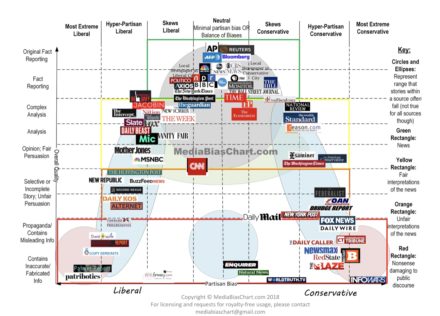Source of article The Jury Room - Keene Trial Consulting.
 We hear so much about “the liberal media” these days that this infographic made us stop and review carefully. It was interesting to see that some of the sites we had casually mentally categorized as either liberal or conservative were truly neither and instead gave a “balanced” view of the news (according to the patent attorney who ranked them).
We hear so much about “the liberal media” these days that this infographic made us stop and review carefully. It was interesting to see that some of the sites we had casually mentally categorized as either liberal or conservative were truly neither and instead gave a “balanced” view of the news (according to the patent attorney who ranked them).
First, let’s start with that attorney. “Vanessa” is a practicing patent attorney in Denver, Colorado (read about her here). Vanessa writes the blog All Generalizations Are False. Further, she actually published and then modified her Media Bias Chart (see her site for a clickable version that will expand to fit your screen) based on feedback from readers (which was remarkably civil for the most part). We applaud her for that choice and, she also applauds herself! Here’s what she says:
I’m a strong believer in changing one’s mind based on new information. That’s how we learn anyway, and I wish people would do it more often. I think it would lead to nicer online discussions and less polarization in our politics. Perhaps people don’t “change their minds based on new information” as much as they should because it is often framed more negatively as “admitting you are wrong.” I don’t particularly mind admitting I’m wrong.
In any event, I’m making some minor updates, corrections, and improvements based on feedback I’ve gotten. I’ve been fortunate to hear from many of you thoughtful observers out there, and I’m so grateful that so many of you care about the subject of ranking quality and bias.
There are a plethora of interesting graphics like this one on her site and we encourage you to visit her and review the information there. There is little of the partisan bickering or ad hominem attacks you see on many website comment sections—perhaps because she is trying to present information clearly and is open to other perspectives. That is perhaps a lesson to us all as we navigate increasingly partisan interactions.
From a litigation advocacy perspective, these charts can tell you who your jurors are listening to, who they see as reliable sources (or entertaining sources) of information, and perhaps—if you look closely and listen carefully—how to capture their attention and openness to your case.

